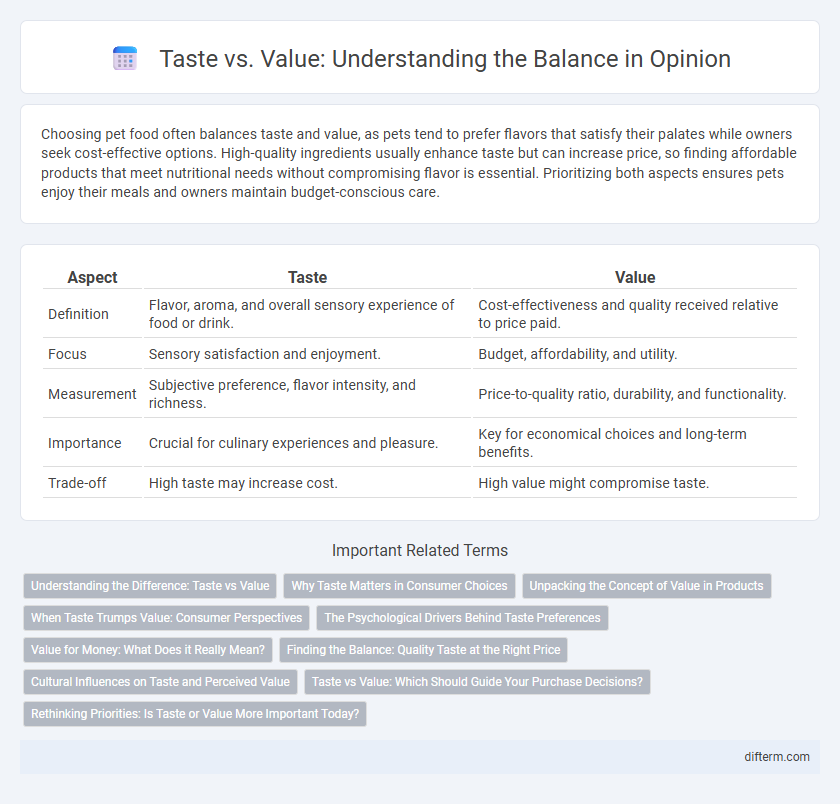Choosing pet food often balances taste and value, as pets tend to prefer flavors that satisfy their palates while owners seek cost-effective options. High-quality ingredients usually enhance taste but can increase price, so finding affordable products that meet nutritional needs without compromising flavor is essential. Prioritizing both aspects ensures pets enjoy their meals and owners maintain budget-conscious care.
Table of Comparison
| Aspect | Taste | Value |
|---|---|---|
| Definition | Flavor, aroma, and overall sensory experience of food or drink. | Cost-effectiveness and quality received relative to price paid. |
| Focus | Sensory satisfaction and enjoyment. | Budget, affordability, and utility. |
| Measurement | Subjective preference, flavor intensity, and richness. | Price-to-quality ratio, durability, and functionality. |
| Importance | Crucial for culinary experiences and pleasure. | Key for economical choices and long-term benefits. |
| Trade-off | High taste may increase cost. | High value might compromise taste. |
Understanding the Difference: Taste vs Value
Taste reflects personal preferences shaped by individual experiences and cultural influences, while value relates to the objective worth or utility of an item. Understanding the difference between taste and value helps in making informed decisions that balance emotional satisfaction with practical benefits. Recognizing how subjective taste contrasts with measurable value can guide consumers toward choices that optimize both enjoyment and investment.
Why Taste Matters in Consumer Choices
Taste plays a crucial role in consumer choices as it directly influences satisfaction and repeat purchases. Preferences in flavor or aesthetics often outweigh price considerations, driving brand loyalty and market success. Understanding consumer taste enables companies to tailor products that meet emotional and sensory expectations, enhancing perceived value beyond cost.
Unpacking the Concept of Value in Products
Value in products extends beyond price, encompassing durability, functionality, and emotional satisfaction that align with individual preferences. Taste shapes perceived worth by influencing how consumers prioritize features such as design, brand reputation, and user experience. Understanding value requires recognizing the subjective interplay between tangible benefits and personal aesthetic judgments.
When Taste Trumps Value: Consumer Perspectives
Consumers often prioritize taste over value when the sensory experience directly influences their satisfaction and emotional connection with a product. High-quality flavors, unique textures, and memorable taste profiles create strong consumer loyalty, even if the price is higher. This preference highlights the intrinsic importance of taste as a primary factor in purchasing decisions, outweighing cost considerations for many buyers.
The Psychological Drivers Behind Taste Preferences
Taste preferences are deeply influenced by psychological drivers such as individual identity, cultural background, and emotional associations. People often value foods and experiences that resonate with their self-concept or social group, leading to subjective perceptions of taste quality. This interplay between psychology and sensory experience explains why perceived value can outweigh objective taste metrics in shaping preferences.
Value for Money: What Does it Really Mean?
Value for money measures the balance between the quality and cost of a product or service, emphasizing durability, functionality, and user satisfaction rather than just taste or appearance. Consumers prioritize long-term benefits and overall performance, seeking items that justify their price through reliability and usefulness. Understanding value for money requires assessing whether the investment aligns with personal needs and expectations beyond initial sensory appeal.
Finding the Balance: Quality Taste at the Right Price
Finding the balance between taste and value requires prioritizing quality ingredients without overspending, ensuring a satisfying culinary experience. Consumers increasingly seek products that deliver exceptional flavor paired with affordability, driving brands to optimize recipes and sourcing. Striking this equilibrium fosters loyalty and elevates everyday dining by making gourmet taste accessible within budget constraints.
Cultural Influences on Taste and Perceived Value
Cultural influences shape both taste and perceived value, as societal norms and traditions guide preferences and define what is considered valuable. People from different cultures often prioritize distinct flavors, aesthetics, and craftsmanship, which alter their judgment of quality and worth. This cultural lens impacts market demand and the appreciation of products, emphasizing that taste and value are deeply intertwined with cultural identity and experience.
Taste vs Value: Which Should Guide Your Purchase Decisions?
Taste reflects personal satisfaction and emotional connection to a product, while value emphasizes cost-effectiveness and long-term utility. Prioritizing taste can lead to greater enjoyment but may result in higher expenses, whereas focusing on value ensures practical spending and maximizes return on investment. Balancing taste and value allows consumers to make informed purchase decisions that align with both their preferences and financial goals.
Rethinking Priorities: Is Taste or Value More Important Today?
Consumers increasingly prioritize value over taste as economic uncertainty pressures budgets, prompting a shift toward cost-effective choices that do not compromise quality. Market trends reveal a growing demand for products offering durability and multifunctionality, underscoring practical benefits rather than sensory appeal alone. This evolution in consumer behavior challenges brands to balance flavor innovation with affordability to maintain competitive advantage.
taste vs value Infographic

 difterm.com
difterm.com